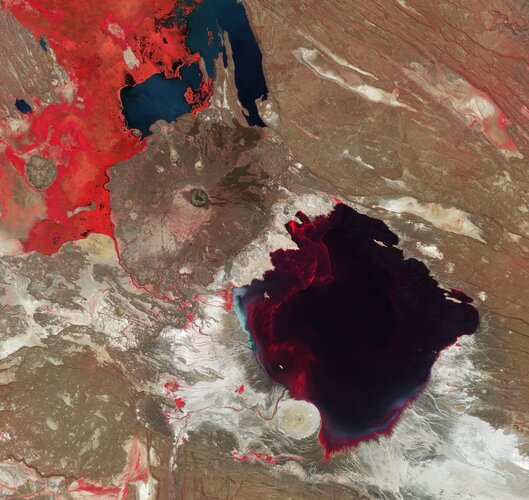Reminiscent of an artist’s pallet, this striking false-colour image captured by the Copernicus Sentinel-2 mission features Lake Abbe in northeast Ethiopia.
Zoom in to explore this image at its full 10 m resolution or click on the circles to learn more.
Visible as the large round dark area, Lake Abbe, also known as Lake Abhe, straddles the border of Ethiopia to the west and Djibouti to the east. The lake is 19 km wide and 17 km long and is extremely salty. It is dotted with clusters of steaming limestone chimneys and surrounded by large salt flats, visible in white, and rift volcanoes. The biggest volcano in the image is Mount Dama Ali, a dormant 25-km-wide shield volcano that rises on the northwest shore of the lake.
Lake Abbe and Lake Afambo, which is visible at the top of the image, are part of a chain of six connected salt lakes, fed by the Awash River – one of Ethiopia’s biggest rivers.
This image was acquired using Copernicus Sentinel-2’s near-infrared channel, which highlights vegetation in bright red, as shown in the top left along the Awash River. This type of band combination also helps to image algal blooms, which can be identified by the red stripes in the dark waters of Lake Abbe. The light blue colour on the west shore indicates sediment discharged into the lake.
Because of its dry, desert, almost lunar landscape and the steaming, sulphuric vents, Lake Abbe is considered one of the most inaccessible areas on Earth. Earth observation satellites are key in these cases as they are particularly relevant for monitoring remote regions such as this.



 Image:
Reminiscent of an artist’s pallet, this striking false-colour image captured by the Copernicus Sentinel-2 mission features Lake Abbe in northeast Ethiopia.
Image:
Reminiscent of an artist’s pallet, this striking false-colour image captured by the Copernicus Sentinel-2 mission features Lake Abbe in northeast Ethiopia.